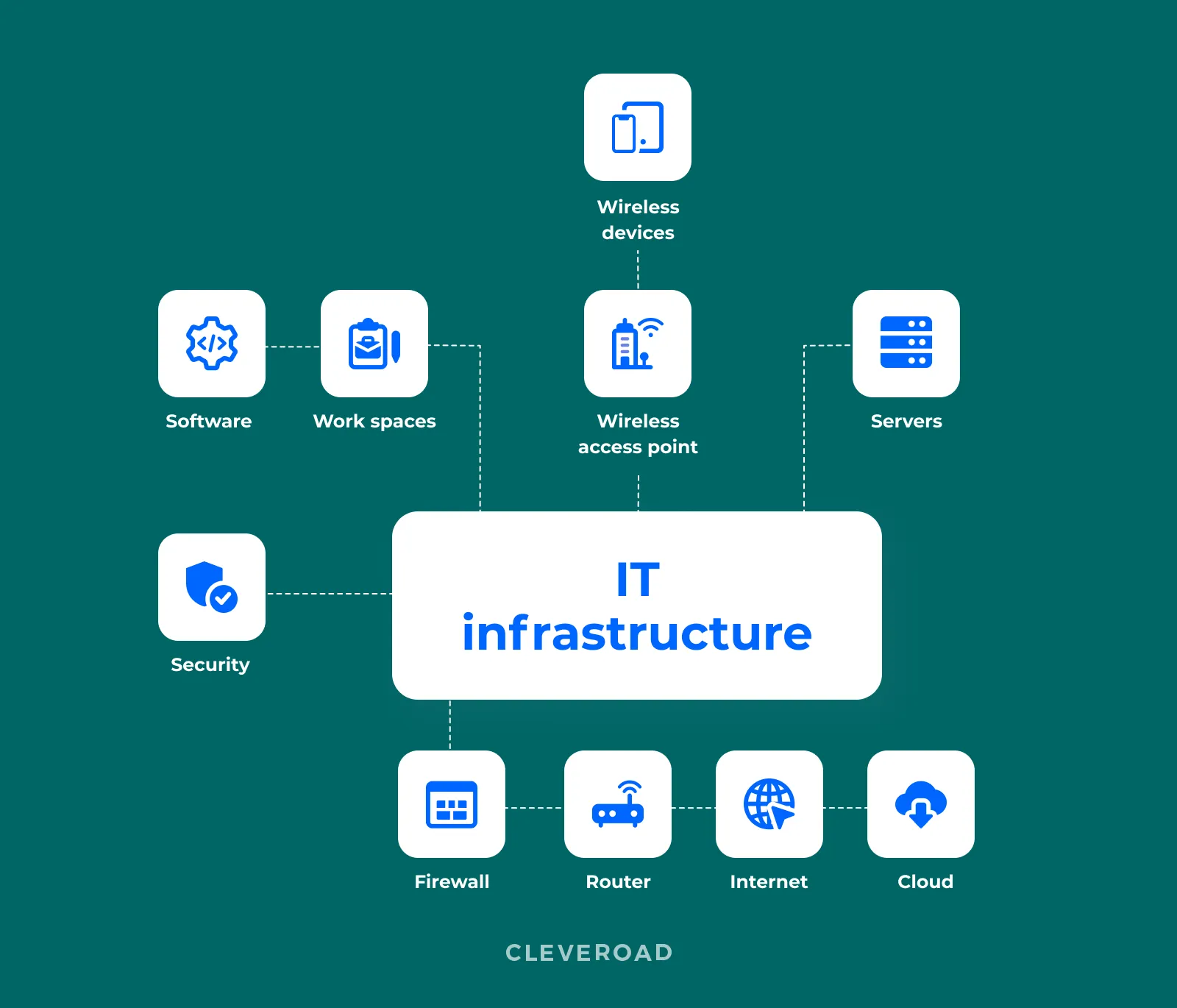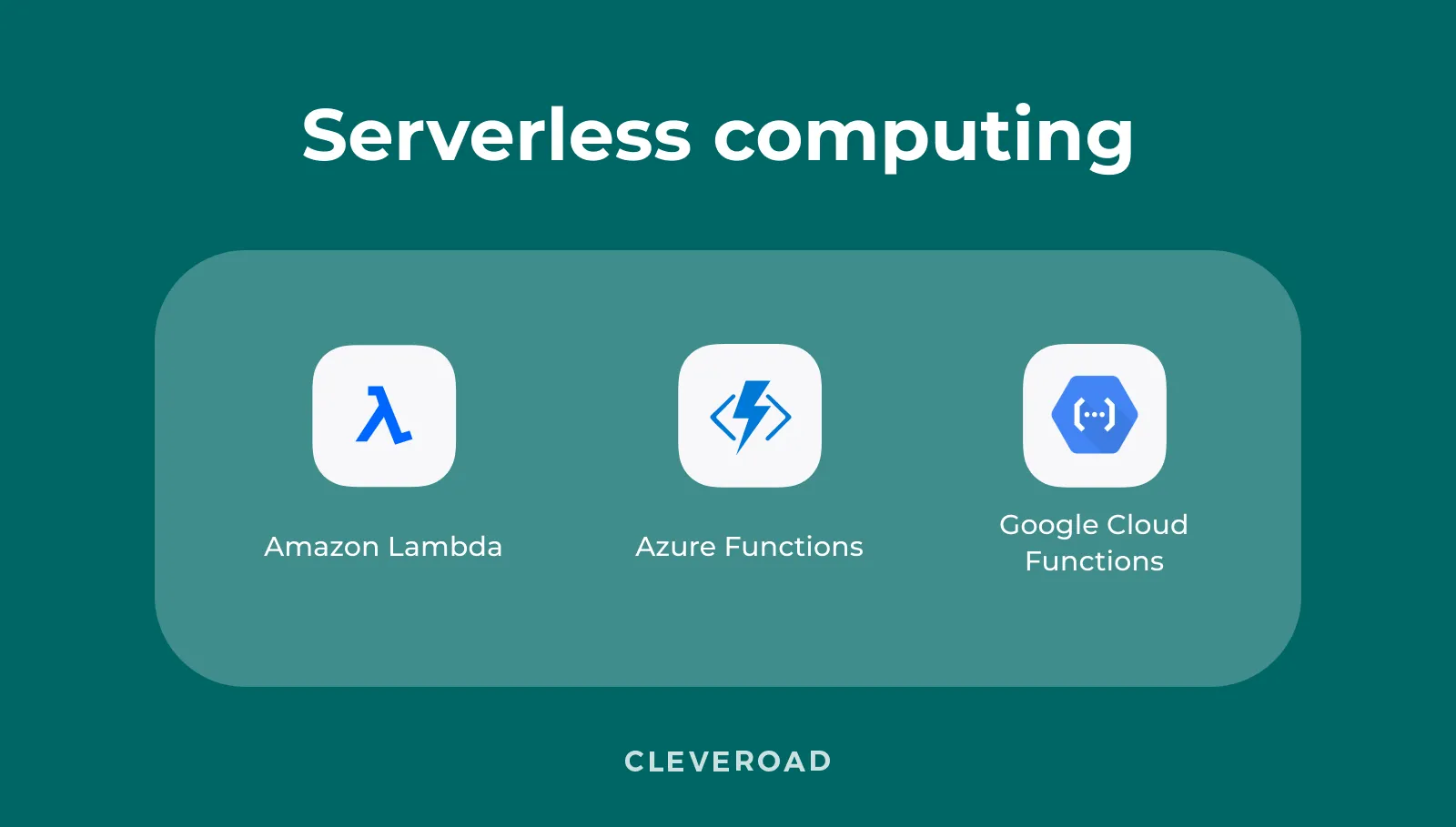How to Reduce IT Infrastructure Costs: Practices to Follow
Updated 22 Dec 2022
10 Min
2455 Views
Every business wants to cut expenses as much as possible. In the long run, it is hardly wise to lay off core employees or simplify the production process. Thus, when it comes to proactive saving up, IT infrastructure cost is normally put under healthy reduction.
Information technology or IT infrastructure essentially refers to the wide range of components required to operate and manage business IT environments. The list of components IT infrastructure consists of includes but is not limited by hardware and software assets, firewalls, wireless access point, etc.
These days, cloud IT infrastructure gains popularity due to its convenience. Cloud computing means that all servers, software, and networks are hosted in the cloud. Providers like AWS, Microsoft Azure, and DigitalOcean are ready to provide you with hardware, networking, and more.
Wisely managed IT infrastructure helps businesses increase profit by decreasing the spend. How? The answer is IT infrastructure optimization and in this article we are gonna de-veil the greatest tricks of its practical implementation.

IT infrastructure
Top 4 Ways to Minimize IT Infrastructure Costs
Let’s discuss top measures and techniques aimed at the most cost and resource-effective utilization of IT infrastructure elements.
Shift to the Cloud IT Infrastructure
These days, cloud computing is the headliner of top-notch solutions aimed at making technology friendly to any data capacity span. An ultimate flexibility of the cloud IT infrastructure is achieved through elimination of the need to host its “heavy-metal” part in the physical location. Instead, all software and networks are stored in the cloud server which allows you to get precisely the amount of space you need to fulfill your demands, and not go an unnecessary extra mile. Thus, the cloud computing model makes it much easier to exercise control over the cost of IT infrastructure.
Another fact grounding popularity of cloud-based solutions is associated with their holistic stability. Cloud IT infrastructure is completely independent in terms of outside environment conditions (such as electricity supply), which ensures fail-safety of a company’s workflow.
Scalability of cloud IT infrastructure also makes it incredibly cost-effective. For example, if your app experiences a spike of users, the cloud will deal with it by increasing the space dynamically. Alongside, in case of shrinkage of the user flow, cloud application development platform can help you scale the capacity down and pay less.
Providers like AWS, Microsoft Azure, and DigitalOcean are ready to provide you with hardware, networking, and other components of a consistent IT infrastructure.
If you want to outsource IT infrastructure management, check our guide to managed IT services to learn more about its types and benefits.
At Cleveroad, we work with AWS services. Amazon offers a bunch of solutions like Amazon EC2, Amazon SS3, and Amazon Aurora.
Amazon EC2
Elastic Compute Cloud offers dynamic infrastructure scaling. Additionally, it provides a possibility to increase server capacity on the go.
Amazon RDS
Amazon offers a reliable database called Relational Database Service to scale quickly and adapt to emerging loads.
Amazon S3
This service is used for storing objects and guarantees data safety and availability.
Amazon CloudWatch
Every system needs monitoring, so CloudWatch tends to keep track of emergencies.
Adjust IT infrastructure solutions to your needs
Although wasted costs constitute a substantial part of revenue, most IT companies tend to underestimate the impact of that factor. To this end, next in the line of valuable components is calculation and estimation of the company’s up-to-date needs.
Each IT infrastructure (traditional or cloud) requires deep and comprehensive knowledge of the run projects to be effective. Correct estimation of the project specifics enables further accurate prediction of its subsequent needs. This approach allows sticking to the basics of IT services while retreating from redundant pieces of software.
The next question that logically arises here is how does IT infrastructure reduction is translated into practice? In order to get a correct future scope of services, it’s wise to take the following steps:
- Consider the things disposition: what software is on the run, how much storage space is used, what equipment is utilized, etc.
- Estimate your actual relevant needs at the moment via every point
- Based on the previous calculations, predict your needs for a 6-month period according to your business strategy
- Reduce the amount and scale of assets to the minimum of IT infrastructure
For greater results, it is worth consulting with experts that can also help you reduce software development costs correlated with infrastructure prices. Professional engineers will analyze your business needs and calculate the span of ad hoc resources.
Manage hardware components of IT infrastructure
Talking about IT infrastructure and its leveraging, special attention should be paid to the hardware (sure, only in case you have a physical on-site storage). Physical hardware is a peculiarly demanding set of IT infrastructure, which requires constant monitoring. Precisely, it’s vital to run regular estimations of how much storage space is occupied by the assets, and how much is still available.
In case you’ve faced the need for additional space, before running for a full hardware refresh, make sure you adjust it to the precise needs of a newly implemented service or product. Maintenance of IT infrastructure is also critical as it prolongs your current hardware existence, thus sparing your financial resources!
Monitor billing of IT infrastructure service
This tip primarily has to do with cloud computing as this option implies receiving bills from the server provider. Despite paying the provider a flat rate, finance allocation still can be confusing. With a wide variety of utilized services, it’s perfectly easy to miss the moment when your hardware becomes packed with unnecessary assets.
To avoid wasted costs, it's vital to conduct a detailed IT infrastructure cost breakdown and then track the billing flow process via each specific compound. Follow the next recommendations to make the process effective:
- Set alerts to get notifications if you reach a pre-set financial threshold
- Adjust your IT infrastructure cost model to the up-to-date needs of your projects
- Check billing and usage reports on a regular base
- Use provider’s cost management tools to make effective IT infrastructure costs estimates
For example, AWS offers to monitor usage and expense with AWS Cost Explorer and AWS Budgets.
AWS Cost Explorer
AWS Cost Explorer has an easy-to-use interface that lets you visualize, understand, and manage your AWS costs and usage over time. The system offers a set of default reports. From there, you can use the filtering and grouping capabilities to dive deeper into your cost and usage data and get insights.
AWS Budgets
AWS Budgets allows you setting custom budgets to track your cost and usage from the simplest to the most complex use cases. With AWS Budgets, you can choose to be alerted by email or SNS notification when actual or forecasted cost and usage exceed your budget threshold.
AWS offers to monitor usage and expense with AWS Cost Explorer and AWS Budgets.
How to monitor and manage your AWS costs
Utilize serverless computing
Talking about what is IT infrastructure, hardware is among its most substantial elements in terms of cost formation. But wouldn’t it be amazing if companies could just focus on the development without the need to worry about servers?
Many asked that question. Luckily, it hasn’t been left unanswered, and serverless computing entered the stage of cutting-edge IT development. A cloud computing model presupposes such an organization of cloud IT infrastructure where the responsibility for cloud maintenance is held by the cloud provider. With serverless IT infrastructures you are guaranteed to only use a truly necessary amount of cloud storage as the hardware resources are allocated on demand. Serverless computing is strongly associated with the concept of feature as a service.
Martin Fowler
Developer
Feature as a service (FaaS) is a category of cloud computing services that provides a platform allowing customers to develop, run, and manage application functionalities without the complexity of building and maintaining the infrastructure typically associated with developing and launching an app.
Below you’ll find a list of top practical tools for utilizing serverless computing.
AWS Lambda
AWS Lambda is a serverless computing service to run code without provisioning or managing servers, creating workload-aware cluster scaling logic, maintaining event integrations, or managing runtimes.
Azure functions
This tool offers the ability to run custom code on demand and at scale in the cloud. Azure Functions offer to build and debug locally without additional setup, deploy and operate at scale in the cloud.
Google Cloud Functions
Google Cloud Functions is a serverless execution environment for building and connecting cloud services. With Cloud Functions you write simple, single-purpose functions that are attached to events emitted from your cloud infrastructure and services.
Most cloud providers offer serverless computing, for example Amazon Lambda, Azure Functions, and Google Cloud Functions.

Tools to use for serverless computing
Staffing Options for a Better IT Infrastructure Cost Model and Management
Since no IT infrastructure of a company just goes by itself but is managed by relevant members of staff, the human factor is critical for the purposes of IT infrastructure optimization.
To that end, have you already heard of DevOps? Today, by common consent of the IT realm, DevOps is considered to be the most progressive approach to the labor force’s inner organization. The zest of the DevOps’s philosophy is that it blurs the lines between separate job roles, and thus dissolves the boundaries between development and other related operations. Engaging DevOps for the IT infrastructure support means that no project-related data is omitted but is instead constantly exchanged between all the parties involved.
In a DevOps environment no job performer is isolated: developer works hand-in-hand with a system administrator, and a marketing specialist, and a designer, and so on. Each team member is part of the ship, part of the crew.
Such non-stop cross-departmental cooperation boosts awareness of what components are available, what are still necessary to gain, and what can be reduced to increase the end profit.
Things to outsource
There are two main roads you can take to hire a qualified DevOps engineers’ team: going for in-house developers or cooperating with a reliable vendor providing outsourced DevOps services.
Each option has its own pros and cons. For example, an in-house team makes the communication easier but requires a bunch of additional expenses (rent, hardware, software, vacations, and more). On the other hand, outsourcing provides you with experienced developers and well-adjusted IT infrastructure at a lower cost. That’s why hiring a software development company via outsource is another great answer to the “how to reduce IT infrastructure costs“ question.
Outsource app development cost will vary depending on the region and the expertise level of software engineers. Outsource app development cost. For example, a DevOps engineer from North America can cost you at least $192,000 yearly (based on 40 working hours per week). Considering that you need several specialists, it costs a fortune. On the contrary, DevOps specialists from Eastern Europe require drastically less $48,000 yearly.
| Region | DevOps engineer rates |
North America | $100-$149 |
Australia | $100-$149 |
Western Europe | $100-$149 |
Asia | $49-$100 |
Eastern Europe | $25-$49 |
India | $25 |
Want to outsource DevOps?
Contact us to discuss your project and get consulted by an experienced DevOps
Benefit from on-demand hiring
Recently, there was a chance to observe the proliferation of temporary hiring options, commonly referred to as on-demand. In contrast to the scenario where your e-business is supported by a permanent team of dedicated specialists 24 hours per day, 7 days per week, the on-demand option is only there for you for a limited amount of time. Or, to be more precise, it is there for you just as long as you need it to accomplish a comparatively simple and straight-fourward task.
The most important thing is that you can take advantage of the on-demand hiring might to add power to your infrastructure components in the most resource-efficient manner. Let’s look at the two examples of wide-spread on-demand hiring options.
Break/fix
Break/fix companies are like pit stops in the digital world. While IT companies, small and large, are trying to outrun each other in the race for customer loyalty, a slightest break on the race track can lead to a serious recession. Simply put, break/fix companies provide repair and upgrade services when an ad hoc request is issued by the client.
Now, when it comes to tech infrastructures, applying to break/fix allows fixing any component of them which experiences a downfall in a prompt and cost-efficient manner. The price for the service provided is either calculated based on an hourly rate, or already comes in flat if the service bears routine nature.
Remote hands
This option can be useful in renovation of IT infrastructure of the related issues. Specifically, companies working in the “remote hands” format run so-called colocation centers, where specialists hired by the contractor provide customers with remote tech assistance. Going for remote hands is a great decision if there is a problem with some components of infrastructure requiring quick and straightforward troubleshooting without the physical presence of an ad hoc specialist.
How Cleveroad Can Help You with IT Infrastructure Costs Optimization
Cleveroad is a software development company headquartered in North Europe, Estonia. For more than 10 years we’ve been managing and maintaining cloud IT infrastructure for our customers.
Our DevOps engineers can help you:
- Create, adjust, support, and optimize integration and code delivery tools (Jenkins, Bamboo)
- Interact with Version Control Systems (Gitlab, Github, Bitbucket)
- Automate processes by creating scripts or using specific technologies like Ansible
- Administrate cloud platforms (AWS)
- Optimize a cloud IT infrastructure
- Integrate a required technology into a company’s IT processes
Get IT infrastructure cost estimate
Contact us to share project details and get a consultation and estimation from our tech experts
- Leverage the cloud
- Predict your project needs
- Monitor your finance allocation
- Go to the serverless computing
With cloud IT infrastructure, you don’t need to host physical hardware equipment and thus, care for its maintenance and security. But the most important in terms of IT infrastructure optimization is the cloud’s scalability, as you can always get precisely the amount of space you need under a fixed price.
The best options are outsourcing vendors working in DevOps format on a constant basis and on-demanding hiring, such as remote hands, for singular occasions.

Evgeniy Altynpara is a CTO and member of the Forbes Councils’ community of tech professionals. He is an expert in software development and technological entrepreneurship and has 10+years of experience in digital transformation consulting in Healthcare, FinTech, Supply Chain and Logistics
Give us your impressions about this article
Give us your impressions about this article
